Relaxing herbs
Medicinal plants are a soothing and effective way to relieve stress. Essential oils (listed in the box alphabetically) are made from highly concentrated essences of plants that have similar health benefits to herbal remedies but are used in aromatherapy.
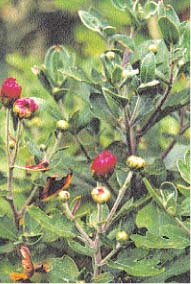
NOTE
You should always consult your physician before starting any herbal treatment.
+ The following are effective stress fighting medicinal plants and herbal remedies. Some plants may be easier to find than others depending on where the plants are cultivated. You can find some as fresh plants or dried, and others in liquid form, tablets or powder.
Mad-dog skullcap
(Scutellaria lateriflora)

- • Parts used. The leaves and flowers of the skullcap plant used for medical purposes are harvested in the summer. This herbal remedy can be taken as a tea and in capsules or liquid form.
- • Skullcap is native to North America. Because of its calming effects on the nervous and muscoloskeletal system, during the 19 th century it was considered to be a remedy for rabies, thus its name “mad dog weed.” It has a bitter taste and a slightly astringent characteristic.
- • It helps the nervous system and aids in fighting anxiety and stress. Because it's also used to treat muscle spasms, it's useful for relieving muscle tension brought on by stress. It carries properties which can help you adapt to hostile environments (brought on by pollution, a difficult living situation or social pressures).
AROMATHERAPY
Aromatherapy is the use of essential oils extracted from plants, flowers, trees, and roots for physical and psychological treatment. Essential oils can be diluted and mixed with other vegetable-based oils because they tend to be costly and very concentrated. Some uses for essential oils: rub into skin during massages, putting a few drops when taking a bath and/or drinking or ingesting (only under strict medical supervision). Using oils in massage therapy is the most common use because it awakens the smell, softens the skin and makes the massage feel even more relaxing (see Essential oils from A to Z box).

ESSENTIAL OILS FROM A TO Z
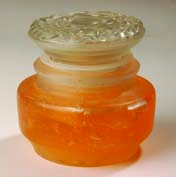
BASIL
Stimulant and anti-depressive; tonic for the nervous system. It refreshes, purifies, and tones the skin. However, you should be cautious because it can irritate the skin. It can be mixed with bergamot, clary sage, geranium, lavender, lime, lemon balm, neroli and sandalwood.
Safety. You should always apply it diluted, if you have sensitive skin.
BERGAMOT
Sedative and anti-depressant; tonic for the nerves. It helps to control oily skin, particularly when skin problems are related to stress. It can irritate sensitive skin, so it's best to use it in low concentrated levels and to avoid direct sun light after its application. It can be combined with geramium, juniper, jasmine, lavender, tangerine, neroli, patchouli, Roman camomile, marjoram, lemon and ylang ylang.
WARNING
Essential oils are for external use only, they should never be ingested. Keep stored away from children and keep away from your eyes.
Ginseng
(Panax ginseng)

- • Parts used. The plant's root is extracted for capsules.
- • Ginseng is cultivated in Northeastern China, Eastern Russia and North Korea; it is widely cultivated for holistic medicinal use.
- • The West has long considered ginseng as a tonic to relieve stress through “adaptogen” activity. Ginseng has a “universal defense action” which helps us adapt to hostile environments (pollution, difficult living situations and social pressures).
- • Warning. Do not take ginseng continuously for more than 6 weeks. It can cause insomnia and high blood pressure. It's best to avoid coffee or caffeinated tea while using ginseng.
This remedy is not recommended for pregnant women or for children under 12 years old.
FOR OCCASIONAL STRESS
Chew on 0.5-1 g of ginseng root daily, or use the root as a garnish in foods.
SIBERIAN GINSENG
Siberian ginseng is native to Siberia, Russia and was used by Russian astronauts to maintain their stamina, immune system and to fight stress. Fresh or dried Siberian ginseng root is not available on the market, you can only buy it in capsule form, made from the base of the root. It also carries “adaptogen” properties, similar to ginseng.

St. John's Wort
(Hypericum perforatum)
- • Parts used. The leaf and flower of St. John's Wort are collected in the summer months, when they blossom. The leaves and flowers can be taken as a tea (fresh or dried).
- • Also known as “St. John's plant”, it's native to Europe, but today it is grown throughout most of the world.
- • It's mainly used to fight depression, especially for women at the stage of menopause.
- • Warning. Sun exposure while taking St. John's Wort can cause skin problems because the skin becomes more sensitive to the sun. You shouldn't take this herbal supplement if you are taking birth control pills, blood clotting drugs, anti-viral drugs used in the treatment of HIV, or anti-depressives.
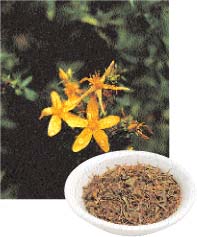
TO FIGHT EVERYDAY STRESS
Tea made with skullcap, St. John's Wort, lemon balm and vervain is a great calming remedy. Mix 1 tablespoon (dried herb) or 2 tablespoons (fresh herb) with 2 cups of boiling water and filter. You can drink up to 4 cups a day of the tea made with any of these herbs. With St. John's Wort, you must wait 2 to 3 weeks for results.
ESSENTIAL OILS FROM A TO Z
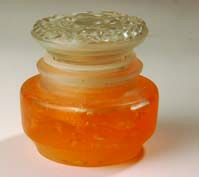
CLARY SAGE
Alleviates stress; it has properties that rejuvenate the skin. Its fragrance mixed with alcohol can produce nausea. Blend with bergamot, myrrh, geranium, jasmine, juniper, lavender and sandalwood.
Safety. It shouldn't be used during pregnancy. If used in concentrated amounts this essential oil can cause negative side effects or a narcotic effect.
EUCALYPTUS
Helps to relieve puffy skin. It should always be used diluted. If used too often, it can irritate your skin. Combine with bergamot, juniper, lavender, lemon, lemon balm and rosemary.
Safety. It shouldn't be used if you have high blood pressure or if you have symptoms of epilepsy.
Lavender
(Lavandula officinalis)
- • Parts used. The flowers are most commonly used, the stems are also often used for decoration.
- • Lavender grows all over Europe and in North Africa; also, it's cultivated in a number of countries such as France and the US. It has a strong, pleasant fragrance. The leaves can be added to salad, replacing mint.
- • It is used to soothe and promote sleep, helping to relieve heart palpitations and insomnia. It can be had as an infusion and lavender oil can be rubbed on the skin or used in baths.

Hops
(Humulus lupulus)
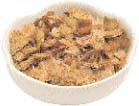
- • Parts used. Hops are the corn-like, fruiting bodies (strobiles) of the plant and are typically harvested from cultivated female plants that contain gray seeds, which are covered with yellow glands. Hops are cultivated in the summer. The fruit can be used to make infusions, liquid extract, syrups, or pills.
- • A perennial vine that grows in humid conditions and needs plenty of sun. It grows in abundance in the northern Iberian Peninsula, but is widely cultivated throughout the world. It has a pleasant aroma and a slightly bitter and spicy taste.
- • Hops have been found to have mild sedative properties; fight insomnia, heart palpitations and excessive nervousness.
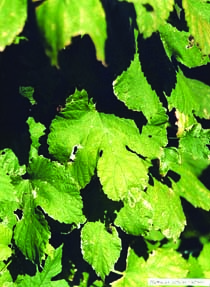
SEDATIVE INFUSION
Pour boiling water in a cup with a few spoonfuls of dried hops fruiting flowers. Let it steep for 10 minutes; filter and drink before going to bed.
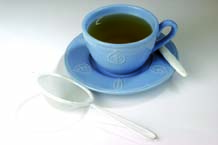
ESSENTIAL OILS FROM A TO Z

GERANIUM
Tones and relaxes the nervous system. It's beneficial for every skin type: it increases blood flow to the skin and normalizes oil production that maintains the skin's elasticity. One drop can be used on the affected area of the skin. When used in excess it can irritate sensitive skin. Mix with bergamot, clary sage, jasmine, juniper, lavender, tangerine, neroli, patchouli, Roman camomile, rose, rosemary, sandalwood and basil.
GINGER
Acts as a tonic for the nervous system; bath soothing and a stimulant. If you have sensitive skin, it's best to use ginger oil diluted. Blend with eucalyptus, myrrh, geranium, lemon, tangerine, patchouli, Roman camomile, rose, rosemary, sandalwood and vetiver.
Camomile
(Matricaria Chamomilla L.)
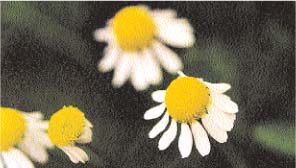
- • Parts used. The flower-heads or capitula are harvested in the spring. Camomile can be prepared as a tea, using 1 generous spoonful per cup of boiling water. It is also used as a decoration and as a dye.
- • Although this plant is native to Europe, it is also grown in North America.
- • It calms the nerves and fights muscle spasms; it produces a wonderful soothing effect and aids the digestive system, especially when under stress.

Lemon balm
(Melissa officinalis)
- • Parts used. The leaves are harvested in the summer before the flowers fully blossom and are used (fresh and dried) in a number of ways. An infusion of fresh lemon balm leaves is a great relaxing tonic. It also can be used as a furniture stain.
- • Lemon balm has been used for centuries in Europe, the Far East and Northern Europe and is grown all over the world. It has a slight taste between bitter and sweet.
- • It's used as a relaxing tonic to relieve anxiety, slight depression, irritability and digestive problems caused by stress.
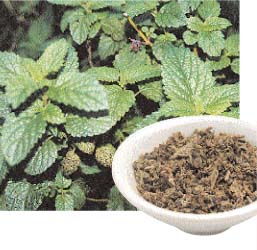
ESSENTIAL OILS FROM A TO Z
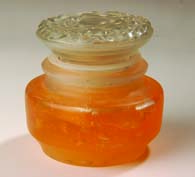
LAVENDER
Helps with mood swings, regulates the central nervous system and calms the spirit. When used on the skin, it stimulates cell growth and regulates excess oil, especially when blended with bergamot. Mix with bergamot, clary sage, geranium, jasmine, lemon, tangerine, neroli, patchouli, Roman camomile, rose and rosemary.
Safety. If you have low blood pressure, lavender can make you drowsy.
LEMON BALM
Rejuvenating and anti-depressive it is calming and relaxing. Mix with myrrh, geranium, ginger, jasmine, juniper, lavender, neroli, Roman camomile, rose, rosemary, basil and ylang ylang.
Safety. It should be avoided during pregnancy and can irritate sensitive skin.
Passion flower
(Passiflora coerulea)
- •Parts used. The flowers and leaves are used in infusions. The fruit is edible.
- • Native to Central America where it's grown most commonly in gardens. A species with similar characteristics, the Passiflora incarnata, is grown in Europe.
- • One of the best remedies against nervous attack, it doesn't have any side effects. Passion flower has sedative and soothing properties, but it is not depressive. It also makes you sleepy. Ideal for work related stress, mood swings and nervousness brought on by premenstrual syndrome and menopause.
- • Warning. Do not use passion flower if you are pregnant or breast-feeding. Do not administer to children under 3 years old. For children under 12 years old, consult a medical specialist, because the dose should be proportioned to the weight of the child. Eat passion fruit only when very ripe, because the fruit has toxic properties before ripening.
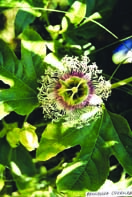

INFUSION OR CALMING LIQUOR
Make an infusion adding 2 spoonfuls of dried passion flower to 2 cups of water. Allow to steep and strain. Drink 2 or 3 cups a day. Using the same proportions, allow the passion flower to soak in ethilic alcohol (30 degrees) for a week. Filter and drink 25 drops a day.

Rosemary
(Rosmarinus officinalis)
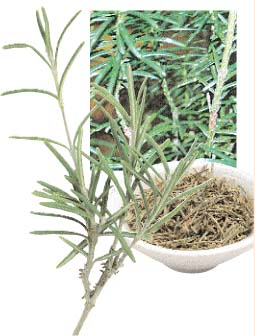
- • Parts used. The leaves and sometimes the flowers are used in an infusion (1 teaspoon of dried leaves a day) or in liquid form (1 to 2 teaspoons daily).
- • Native to Europe, but widely used throughout the world.
- • It has tonic properties and stimulates the nervous, circulatory and cardiovascular systems. It is an anti-spasm and coleretic. It acts as a stimulant, which is beneficial for worn out nerves.
- • Warning. In some cases rosemary, as a side effect, can obstruct to the bile duct.
ESSENTIAL OILS FROM A TO Z
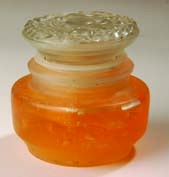
MYRRH
This oil has special soothing properties that stimulate meditation. It's very good for dry, tired or sun burnt skin, because of its tonic and rejuvenating effects; it also acts as an astringent for oily skin. Mix with bergamot, geranium, lavender, tangerine, neroli, patchouli, sandalwood, basil and vetiver.
ROMAN CAMOMILE
It calms mood swings brought on by stress. It's especially good for hypersensitive and dry skin because it improves the skin's elasticity. Blend with bergamot, clary sage, geranium, jasmine, lavender, neroli, patchouli, rose, marjoram and ylang ylang.
Safety . This oil shouldn't be used during the first four months of pregnancy.
Linden
(Tilia sp)
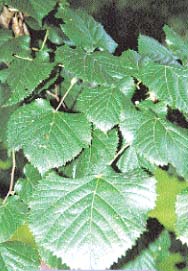
- • Parts used. The flowers, leaves and stems, which can be used as an infusion, as decoration, or to chew.
- • They are also called lime blossoms, linden flowers and tilia. It is native to Europe, where it grows in warm climates with clay-like soil. It is also found in Asia and in North and South America. Although it prefers to grow in a tropical climate, it does grow in some cold areas in Russia. There are different species: Tilia cordata, Tilia platyphyllos, Tilia vulgaris, Tilia tomensosa and Tilia americana, sharing similar properties.
- • Linden is a relaxing remedy for nervous tension and to sooth the heart and digestive system affected by stress.
It has sedative and anti-spasm properties. It doesn't have any side effects.
SLEEPY RECIPE
Prepare an infusion with 3 teaspoons of linden flower and 4 cups of boiling water. Set to steep and strain. Drink when you have symptoms of nervous tension.
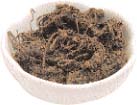
Valerian
(Valeriana officinalis L.)
- • Parts used. The roots, which are harvested during the dry months of spring and autumn. It is used to i make infusions, tinctures, or capsules.
- • It grows in forests, along streams and in humid soil. In ancient times it was used as an anticonvulsant (to treat epileptic convulsions).
- • It acts as a sedative and anti-spasm remedy, soothing the nerves and helping to normalize the heart's rhythm. It also helps bring on sleep.
- • Warning. It shouldn't be used during pregnancy. If used in excessive amounts it can produce vomiting.
ANTI-STRESS INFUSION
In boiling water place 3 teaspoons of valerian root, allow to steep over night and strain. Drink a cup when you feel stressed out. You can add I teaspoon of peppermint to give a pleasant aroma and taste to valerian tea.
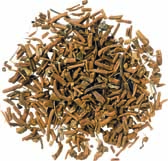
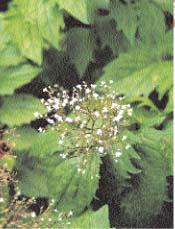
ESSENTIAL OILS FROM A TO Z
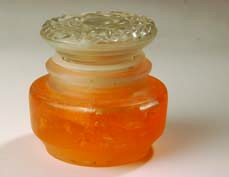
SANDALWOOD
Calms anxiety; softens dry skin. Mix with bergamot, myrrh, geranium, jasmine, lavender, lemon, neroli, rose, basil, vetiver and ylang ylang.
VETIVER
It fortifies the central nervous system, relieves stress as well as physical and mental exhaustion. It helps oily skin. Combine with myrrh, geranium, jasmine, lavender, patchouli, rose, sandalwood and ylang ylang.
YLANG YLANG
Tonic and sedative for the nervous system; regulates the skin's oil production and is beneficial for oily to dry skin. Its properties become even stronger when blended with other essences. It's not recommended if your skin is irritated or puffy. Blend with bergamot, jasmine, lavender, lemon, lemon balm, neroli, patchouli, rose and sandalwood.
Safety. Prolonged use can cause negative effects like headaches.

Comment about this article, ask questions, or add new information about this topic: